Question and Answer December 2013
If you’d like Neil’s help with your plant question, send it to him here. The formatting of this page requires one or more photos. As a practical matter, Neil also suggests that plant ID questions are usually of concern only to the person who has the plant, so those typically don’t make the cut. Please list the city where you live. That will help Neil give you the most accurate answer possible. (Texas is a huge and varied state.) Here are his replies to this month’s questions.
Question: My crabapple is 7 or 8 feet tall. I have noticed severe damage to the southern side of the trunk. South winds have caused the tree to lean northward. Has the stress of the leaning caused the cracks to develop? Can it be saved? K.D., McKinney.
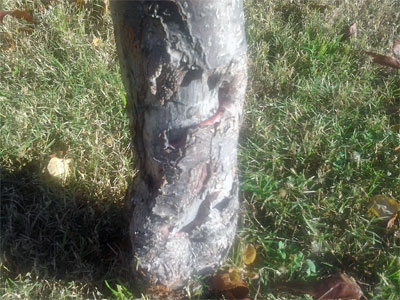
Answer: It looks pretty rough. Hopefully it can heal on its own, but I wonder how physically strong it will be. The internal tissues look badly disturbed. I don’t think the stress caused this crack — at least not on its own accord. You see trees that are much farther out of plumb and whose trunks are doing just fine. This looks more like sunscald, and it looks fairly serious. Whenever I hear about bark being lost on the south or east sides of trunks, I worry first about the drying of the sun’s intense rays. Many a tree has been lost here in Texas due to sunscald and subsequent decay and borer invasion.
Question: This tree was here when I purchased the property four years ago. It is growing well, but it has developed some kind of disease throughout the tree. Is it worth saving? I think it’s a cottonwood. Do you have advice? No name given, Waxahachie.
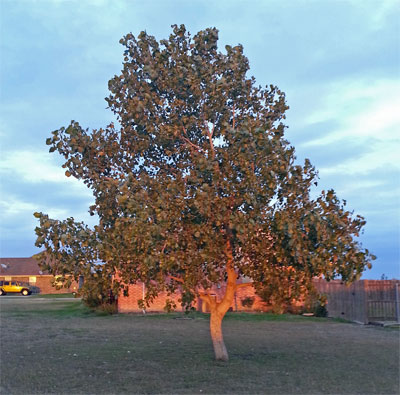
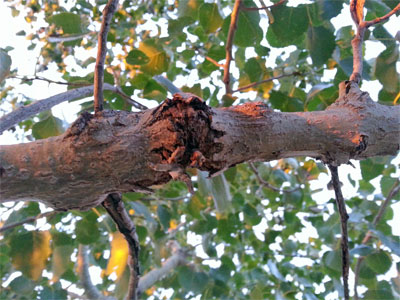
Answer: You do have a cottonwood, but with that severe bend in the trunk and with what appears to be a type of canker that I suspect will just get worse, I would take it out in a heartbeat. There are many superior types of trees, and they will not be susceptible to any bacterial or fungal disease the cottonwood might have had. A certified arborist could probably identify the canker, and the Plant Disease Diagnostic Lab at Texas A&M certainly could, but it’s not really worth the time, effort and money. Invest in the better tree.
Question: My husband’s friend applied pre-emergent weedkiller for us in late September or early October. I know you advise earlier. He fertilized late as well. I am concerned that his applications may have weakened our grass. I think we have had brown patch. Photo was taken several weeks ago. D., Lake Worth.

Answer: I do think that’s too late for pre-emergent applications in your area. I can’t speak to the feeding date, as you didn’t mention when it was, but hopefully that was by early October. Your lawn looks thick, and your home is lovely. As for brown patch, this was a bad year for the fungal leaf disease. If you did have it, it would indeed have weakened the grass, but it will recover. I can’t see it in the image. Your friend’s report also mentioned that he “spot-treated for crabgrass.” I have no idea what he could have used in a St. Augustine lawn that would not have killed the surrounding St. Augustine. The spring pre-emergent applications (early March and early June) in your area are the only way of dealing with crabgrass. You really should not see crabgrass in St. Augustine turf anyway. I wonder if the identification was correct. In summary: I don’t have much of substance to offer other than recommending that you follow the time schedule as accurately as you can.
Question: Both of my Mexican plums (planted two years ago) have rolled leaves. No herbicides have been sprayed near them. Would iron deficiency cause this? (Photo taken before frost.) They appear sick. R., San Angelo.
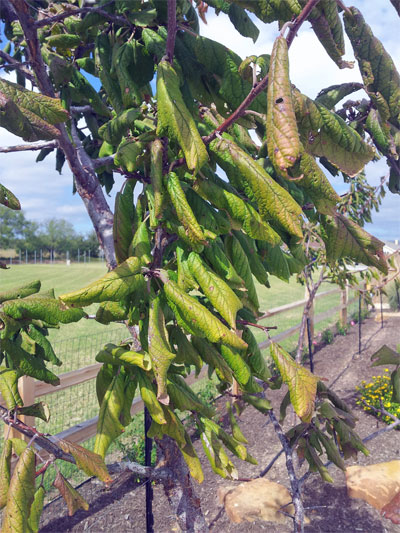
Answer: This is not iron deficiency. Bacterial stem canker of plum branches caused this leaf-rolling to happen on a couple of Mexican plums I had in the DFW area. It causes cracks in the twigs and subsequent oozing of sap that then congeals into small globs. I would look at the branches closely now (I can’t see any conclusive evidence of it from the photo), and I’d watch the trees next spring. If they don’t look better, I’d probably change species. Information from Texas A&M describes it as a weak pathogen whose damage is severe only when trees are weakened by other factors. Your drought of the past couple of years could certainly be a part of the issue. (Although from your photo, it looks like you have had at least some rain this fall.)
Question: What would have snapped the small twigs off my red oaks last month? Is it anything I need to worry about? J.J., Arnold.
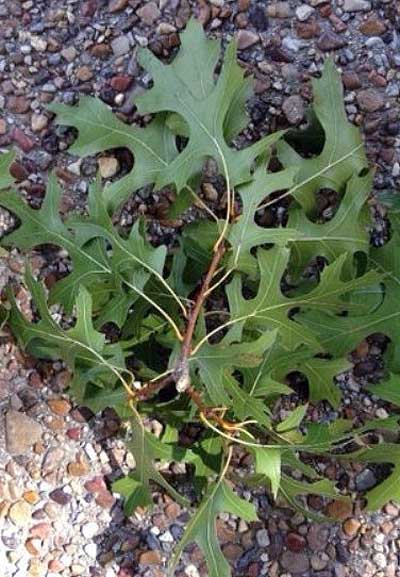
Answer: I believe this may be from twigs that were weakened by some type of insect gall. I think I can see that swelling at the base, where the break occurred. I will admit that the affected leaves usually turn brown before they fall from the tree due to gall attacks. So, it could also be due to squirrels or large birds. Birds would give the cleaner “cut,” while squirrel damage is often more gnawed. This doesn’t look like twig girdler damage, because the twigs are too small.
Question: I’ve been gardening in this soil for 16 years. We add compost to it every year. We planted a nice crop of lima beans. They grew and did well, but they never set fruit. When I pulled them up, I found a layer of what looked like concrete two inches down. What should I do? M.H., no city given.
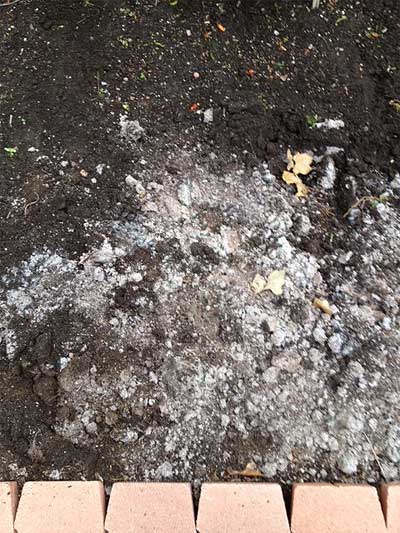
Answer: That’s an unusual question. I know you are very familiar with your garden plot after all of these years, but without knowing where you are, I wonder if you’re seeing a caliche subsoil. Those little white clods look for all the world like what I see in the Blackland Prairie soils around DFW when people try to rototill through one layer and into the next. I don’t know of anything else that could look like this. Lima beans are not easy compared to most other types of beans. If this were my garden soil, I’d continue to add in the organic matter. I would rototill a couple of times over the winter, and I would rotate crops so that no legume goes back into this soil for a couple of years.
Question: I chair a local landscape committee. What should we do with these two crape myrtles? Should we remove them and plant something else, trim the sides again, or cut them at the lower roof line and let them resprout? No name given, Flower Mound.
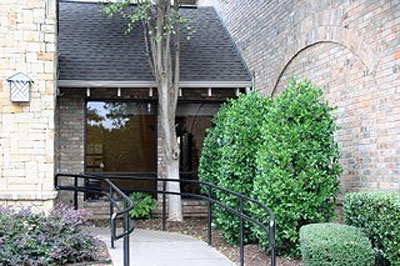
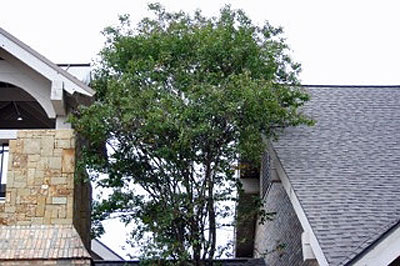
Answer: Remove them! This is a tall variety of crape myrtle that should never have been planted in this sort of setting. Normally I would encourage people to replace the tall types with a shorter variety of crape myrtle, but not in really narrow spaces. Maybe you have room for a Teddy Bear dwarf magnolia. If it’s shady all day long (probably isn’t), you could plant a Japanese maple. Otherwise, perhaps a yaupon holly or Warren’s Red possumhaw holly. I fear that even those are all going to grow too large. You might be better advised just to leave the oval shrubs there and put a piece of garden art or large decorative pottery where the crape myrtles are. A lovely big sundial, garden fountain or statue could be pretty. I think it’s time for Plan B.
Question: I have recently been told this tree is an Eve’s necklace. I’d like to clean it up, but I don’t know how it should be pruned. Lots of the twiggy branches have no leaves. Please advise me. M., Christoval.
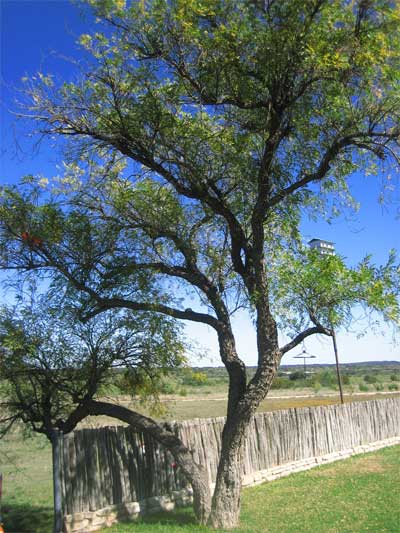
Answer: Other than removing obviously dead twigs and branches, no regular pruning is needed. Obviously your photo was taken while the tree was still green and growing. By now it has no leaves, so you would have a difficult time telling which twigs to remove and which to leave. Wait until spring. It’s always going to have the “rustic” form, so don’t let that bother you.
Question: I have two peach trees that I have grown from seed. They are in pots. One is 2 feet tall, and the other 3 feet tall. Can I leave them in pots outdoors over the winter? I’m not sure where to plant them. My soil is very rocky/sandy. Rev. V.C., Honey Grove.
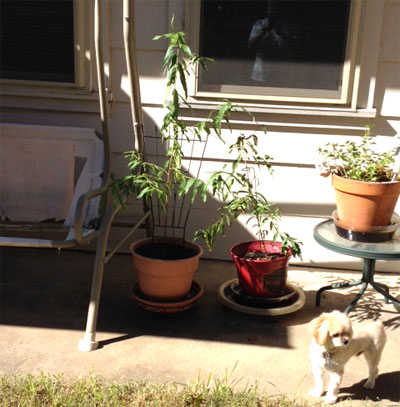
Answer: Pastor, they should be able to withstand winter weather outdoors, even along the Red River, if you keep them moist at all times. To be sure, however, consider digging holes and setting them into the holes temporarily, still in their pots. Pull the soil up around the pots to insulate them. You just have to remember to plant them permanently come spring. They need full sun and a place where they can grow to be 16 or 18 feet wide. They will bear fruit, although not of the same variety as the mother tree that produced the original peaches. As we say in horticulture (and sometimes in real life), “Their daddies were from different neighborhoods.”
Question: How do I know when to remove spent flower heads from hydrangeas? I always fear there will be more flowers coming if I trim them too early. How can I get their color to stay all year? B.R., Arnold.
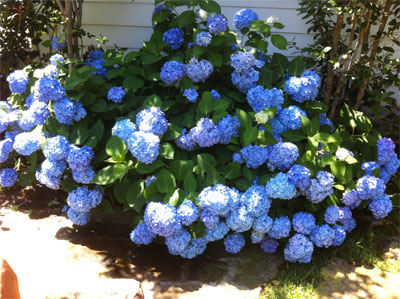
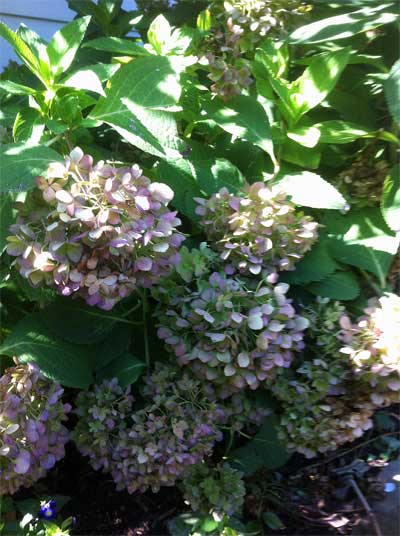
Answer: Hydrangea “flowers” are actually floral bracts. As with poinsettias and dogwoods, the colorful portions are actually modified leaves. The hydrangeas will have the brilliant colors for a period of time, then they will gradually fade to a chaff-like color. There are people who feel the tan mop heads in the garden are attractive. They even use them in floral design. There are others (of us) who do not care to see spent flower parts in our gardens, and we trim them as soon as most of the bright color has dissolved into tan. Neither group is right or wrong. It’s totally your call.
Question: Are these live oak seedlings coming up in the mulch beneath my big tree? Is this unusual root typical? Also, I never knew that live oaks had pointed leaves. J.J., No city given.
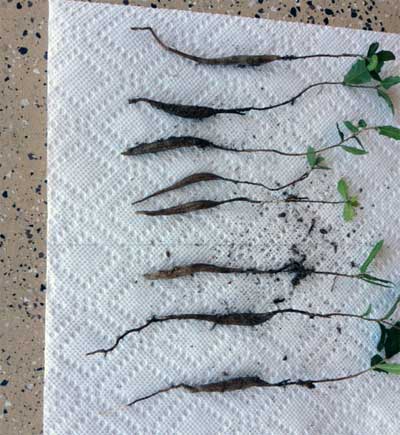
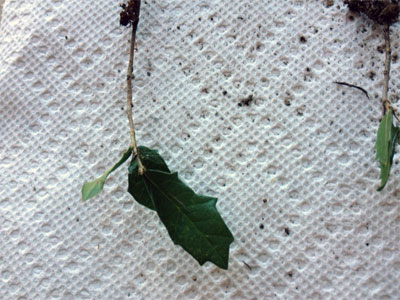
Answer: These are tiny live oak saplings. I do see some side roots starting to develop, which lets me believe they might be germinating seedlings, but sometimes when they come up beneath an existing live oak they end up being suckers – sprouts from a larger root. Suckers really never develop into full-fledged trees on their own right. They remain tethered to the mother tree, eventually forming a thick ground-covering mat of oak foliage that must be trimmed away. Fortunately, only 10 percent or so of our live oaks do this. If you felt resistance when you dug them, or if you had to snap or cut them away from a larger root, they’re suckers. If they pulled straight up like carrots, they’re seedlings. Young foliage on all live oaks takes on the same holly-like leaf appearance. Shumard red oak seedlings, by comparison, have juvenile leaves that have no lobes. Time then changes all that.
Question: What plants would improve the looks of this south-facing wall of my house? The planting bed is only 31 inches wide. K.Y., Richardson.
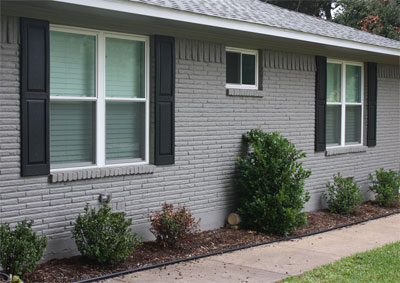
Answer: I have a surprise answer for you, which I’ll save until the end. Rather than trying to use any symmetrical arrangement of highly trimmed and manicured plants, I would stick with the two or three types that would stay small and not require shearing. They would include dwarf yaupon holly, dwarf Burford holly and compact or Harbour Dwarf nandinas. I might try a small trellis with a compact vine to get vertical dimensions into the bed without taking up valuable bed space. I would put my annual color in large decorative pots (24-inch diameter, for example) of a dark color.
So that’s Answer One. My real answer is that if I bought your house, I would remodel that sidewalk. It is your enemy. It repeats the straight lines of your house, and it forces you to plants shrubs that further repeat the straight lines. It’s amazingly quick and easy to sledge hammer an old sidewalk out of the way. It’s a 4-hour job for an industrious gardener or a landscape contractor. Then you would be freed to develop a wonderful new walk design 7 or 8 or 10 feet out from the house, so that you could develop a beautiful garden in the newly enlarged space. (Warning: sales pitch follows.) You ought to sign up for our home landscape school. This is exactly the type of project we enjoy helping people achieve. The class will be all day Feb. 15 in Plano. You’ll see all the details in this issue of e-gardens. We are virtually coming to your backyard to teach it!

